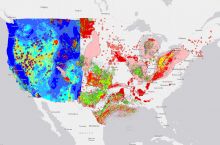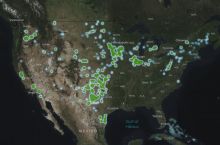Wind energy is harnessed by wind turbines, which convert the energy of the wind into electricity. Wind energy is one of the largest sources of renewable energy.
Wind farms are most effective in areas with high and steady wind speeds, such as the central United States: Texas, Oklahoma, Kansas, and Iowa together produce around half of all the wind power in the country. Wind speed generally increases with height, which is why wind turbines tend to be very tall.
Wind speeds over the ocean tend to be faster and steadier than on land. As a result, some countries have developed offshore wind farms, which come with their own geoscientific and engineering challenges. The first offshore wind farm in the United States began producing electricity off the coast of Rhode Island in 2016.
Why does wind energy matter?
Wind energy is used to generate around 6% of the electricity in the United States. U.S. wind power capacity has doubled since 2011. Continued improvements in technology, combined with policy incentives, mean that the importance of wind as an energy source in the United States may continue to increase for many years to come. Building more wind farms requires metals and other materials to make wind turbines, including a large amount of neodymium, a rare earth element.
How does geoscience help inform decisions about wind energy development?
Geoscientists study wind speeds and patterns in the atmosphere to find the best locations for wind turbines. For both onshore and offshore wind farms, geoscientists provide information on the underlying soil and rock to help ensure that large turbines can be safely and securely installed while minimizing environmental impact. Geoscientists locate and extract the wide variety of mineral resources required by wind technologies, and help to minimize environmental damages associated with mining for these resources.
Learn More
Introductory Resources
- Wind (Website), Department of Energy
Department of Energy homepage on wind energy, including a variety of information resources and summaries of ongoing projects
- Offshore Wind Energy (Webpage), Bureau of Ocean Energy Management
Information on offshore wind energy, including its viability in the United States
- Wind Explained (Website), Energy Information Administration
Introductory information on wind energy, how and where wind turbines work, types of wind turbines, the history of wind power, and environmental impacts
- Wind Energy Education and Training Programs (Webpage and Map), Department of Energy
Interactive map showing education and training programs for wind energy across the United States
Resources for Educators
- Education Resources Network, AGI's Center for Geoscience & Society
Search for wind energy resources in: Curricula & Instruction, Teaching Media, Outreach Programs
- NGSS Performance Expectations, Next Generation Science Standards
4-ESS3-1, HS-ESS3-2
- NGSS Disciplinary Core Ideas, Next Generation Science Standards
ESS3.A


















